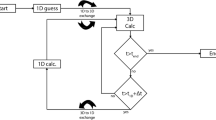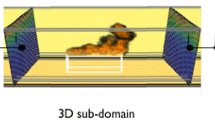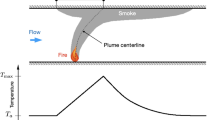Abstract
This paper applies a novel and fast modelling approach to simulate tunnel ventilation flows during fires. The complexity and high cost of full CFD models and the inaccuracies of simplistic zone or analytical models are avoided by efficiently combining mono-dimensional (1D) and CFD (3D) modelling techniques. A simple 1D network approach is used to model tunnel regions where the flow is fully developed (far field), and a detailed CFD representation is used where flow conditions require 3D resolution (near field). This multi-scale method has previously been applied to simulate tunnel ventilation systems including jet fans, vertical shafts and portals (Colella et al., Build Environ 44(12): 2357–2367, 2009) and it is applied here to include the effect of fire. Both direct and indirect coupling strategies are investigated and compared for steady state conditions. The methodology has been applied to a modern tunnel of 7 m diameter and 1.2 km in length. Different fire scenarios ranging from 10 MW to 100 MW are investigated with a variable number of operating jet fans. Comparison of cold flow cases with fire cases provides a quantification of the fire throttling effect, which is seen to be large and to reduce the flow by more than 30% for a 100 MW fire. Emphasis has been given to the discussion of the different coupling procedures and the control of the numerical error. Compared to the full CFD solution, the maximum flow field error can be reduced to less than few percents, but providing a reduction of two orders of magnitude in computational time. The much lower computational cost is of great engineering value, especially for parametric and sensitivity studies required in the design or assessment of ventilation and fire safety systems.















Similar content being viewed by others

Abbreviations
- a,b,c :
-
Fan characteristic curve coefficients
- c p :
-
Air specific heat [kJ/kg K]
- D h :
-
Hydraulic diameter [m]
- D f :
-
Diameter of the fire source [m]
- f :
-
Major losses coefficient
- G :
-
Mass flow rate through a branch [kg/s]
- G ext :
-
Mass flow rate exchanged with the external environment in a node [kg/s]
- G g :
-
Mass flow rate of the gases released from the fire source [kg/m3]
- g :
-
Gravity acceleration [m/s2]
- h :
-
Convective heat transfer coefficient [W/m2 K]
- L :
-
Branch length [m]
- L D :
-
Distance from the fan/fire region to the downstream boundary interface [m]
- L CFD :
-
Length of the CFD domain in the multi-scale representation [m]
- p :
-
Pressure [Pa]
- P :
-
Branch perimeter [m]
- Pr :
-
Prandtl number
- R :
-
Wall-lining thermal resistance [K m2/W]
- T :
-
Temperature [K]
- T ext :
-
External environment temperature [K]
- T g :
-
Temperature of the gases released from the fire source [K]
- U :
-
Overall heat transfer coefficient [W/m2 K]
- v :
-
Flow velocity [m/s]
- z :
-
Node elevation [m]
- β:
-
Minor losses coefficient
- θ :
-
Generic flow quantity [temperature or velocity]
- ε :
-
Average error of the multiscale model [%]
- Φ:
-
Fire heat release rate [W]
- Φ* :
-
Dimensionless fire heat release rate
- φc :
-
Convective fire heat release rate per unit length [W/m]
- λ:
-
Flame radiative fraction
- ρ:
-
Air density [kg/m3]
- ρext :
-
Air density at external environment [kg/m3]
- Δp fan :
-
Pressure gain induced by jet fan [Pa]
- Δp loss :
-
Pressure losses due to friction [Pa]
References
Carvel R (2007) Tunnel fire safety systems. EuroTransp 5(6):39–43
Ferro V, Borchiellini R, Giaretto V (1991) Description and application of tunnel simulation model. Proceedings of aerodynamics and ventilation of vehicle tunnels conference, pp 487–512
Jacques E (1991) Numerical simulation of complex road tunnels. Proceedings of aerodynamics and ventilation of vehicle tunnels conference, pp 467–486
Riess I, Bettelini M, Brandt R (2000) SPRINT––a design tool for fire ventilation. Proceedings of aerodynamics and ventilation of vehicle tunnels conference
Cheng LH, Ueng TH, Liu CW (2001) Simulation of ventilation and fire in the underground facilities. Fire saf J 36(6):597–619
Jang H, Chen F (2002) On the determination of the aerodynamic coefficients of highway tunnels. J Wind Eng Indus Aerodyn 89(8):869–896
Dai G, Vardy AE (1994) Tunnel temperature control by ventilation. Proceedings of 8th international symposium on the aerodynamics and ventilation of vehicle tunnels, Liverpool, UK, 6/8 July, pp 175–198
William D. Kennedy (1997) Critical velocity––past, present and future (revised 6 June 1997). American public transportation association’s rail trail conference in Washington, DC
Wang L, Haworth DC, Turns SR, Modest MF (2005) Interactions among soot, thermal radiation, and NOx emissions in oxygen-enriched turbulent non-premixed flames: a computational fluid dynamics modelling study. Combust Flame 141:170–179
Woodburn PJ, Britter RE (1996) CFD simulation of tunnel fire––part I. Fire Saf J 26:35–62
Woodburn PJ, Britter RE (1996) CFD simulation of tunnel fire––part II. Fire Saf J 26:63–90
Wu Y, Bakar MZA (2000) Control of smoke flow in tunnel fires using longitudinal ventilation systems––a study of the critical velocity. Fire Saf J 35:363–390
Vauquelin O, Wu Y (2006) Influence of tunnel width on longitudinal smoke control. Fire Saf J 41:420–426
Van Maele K, Merci B (2008) Application of RANS and LES field simulations to predict the critical ventilation velocity in longitudinally ventilated horizontal tunnels. Fire Saf J 43:598–609
Armstrong J (1993) The ventilation of vehicle tunnels by jet fans––the axisymmetric case. Proceedings of the seminar on installation effects in fan systems. Mechanical Engineering Press, London
Tabarra M (1995) Optimizing jet fan performance in longitudinally ventilated rectangular tunnels. Separated and complex flows. ASME FED 217:35–42
Karki KC, Patankar SV (2000) CFD model for jet fan ventilation systems. Proceedings of aerodynamics and ventilation of vehicle tunnels conference
Massachusetts Highway Department (1995) Memorial tunnel fire ventilation test program comprehensive test report
Galdo Vega M, Arguelles Diaz KM, Fernandez Oro JM, Ballesteros Tajadura R, Santolaria Morros C (2008) Numerical 3D simulation of a longitudinal ventilation system: memorial tunnel case. Tunn Undergr Space Technol 23(5):539–551
Colella F, Rein G, Borchiellini R, Carvel R, Torero JL, V. Verda V (2009) Calculation and design of tunnel ventilation systems using a two-scale modelling approach. Build Environ 44:2357–2367. doi:10.1016/j.buildenv.2009.03.020
Fox RW, McDonald AT (1995) Introduction to fluid mechanics, 4th edn. John Wiley and Sons, Singapore
Gutiérrez-Montes C, Sanmiguel-Rojas E, Kaiser AS, Viedma A (2008) Numerical model and validation experiments of atrium enclosure fire in a new fire test facility. Build Environ 43:1912–1928
Launder BE, Spalding DB (1974) The numerical computation of turbulent flows. Comput Methods Appl Mech Eng 3(2):269–289
Versteeg HK, Malalasekera W (2007) An introduction to computational fluid dynamics, the finite volume method, 2nd edn. Pearson Prentice Hall, Glasgow
Lacasse D, Turgeon E, Pelletier D (2004) On the judicious use of the k-3 model, wall function and adaptivity. Int J Therm Sci 43(10):925–938
Schlichting H (1979) Boundary layer theory, 7th edn. McGraw-hill, New York
Cox G, Kumar S (2002) Modelling enclosure fires using CFD. In: The SFPE handbook for fire safety engineering, 3rd edn. NFPA, Massachusetts International, Quincy
Lonnemark A, H. Ingason H (2005) Gas temperature in heavy goods vehicles fires in tunnels. Fire Saf J 40:506–527
Heskestad G (2002) Fire plumes, flame height and air entrainment. In: The SFPE handbook for fire safety engineering, 3rd edn. NFPA, Massachusetts International, Quincy
Loennermark A, Ingason H (2008) The influence of tunnel cross-section on temperature and fire development, 3rd International symposium on tunnel safety and security, Stockholm, Sweden, March 12–14
Ingason H. (2008), Model scale tunnel tests with water spray. Fire Saf J 43:512–528
Drysdale D. (2000) An introduction to fire dynamics II edition, John Wiley & Sons Inc. Hoboken, USA
Reszka P, Steinhaus T, Biteau H, Carvel RO, Rein G, Torero JL (2007) A Study of fire durability for a road tunnel comparing CFD and simple analytical models. EUROTUN07 computational methods in tunnelling, Wien. http://hdl.handle.net/1842/1892
Kunsch JP (2002) Simple model for control of fire gases in a ventilated tunnel. Fire Saf J 37(1):67–81
Oka Y, Atkinson GT (1995) Control of smoke flow in tunnel fires. Fire Saf J 25(4):305–322
Lee CK, Chaiken RF, J.M. Singer JM (1979) Interaction between duct fires and ventilation flow: an experimental study. Combust Sci Technol 20:59–72
Ingason H (2005) Fire Dynamics in tunnel. In: Beard A, Carvel R (eds) The handbook of tunnel fire safety. Thomas Telford, London, UK
Acknowledgements
The authors would like to thank Dr Vittorio Verda and Dr Ricky Carvel for their help and the interesting discussions on the subject permitting the publication of this paper.
Author information
Authors and Affiliations
Corresponding author
Additional information
Francesco Colella, Dipartimento di Energetica, Politecnico di Torino, Torino, Italy.
Appendices
Appendix A: Additional Grid Independence Plots
Some of the temperature and velocity contours calculated in the grid independence study are presented in Figure 16. It shows the contours of temperature and horizontal velocity at Reference Section 2 located 100 m downstream the fire source. They are computed for four difference meshes whose characteristics are summarized in Sect. 3.1. As expected from the previous results, the computed solutions show larger deviations for the courses meshes 1 and 2 while convergence is obtained for finer meshes 3 and 4.
Appendix B: Additional Boundary Independence Plots
The results of the boundary independence study relative to the tunnel Reference Section 2, located 100 m downstream the fire are presented in Figure 17. Also in this case, the analysis of the temperature and velocity fields shows that highly accurate results can be achieved with 3D domains whose downstream boundary is at a minimum distance of 100 m from the furthest location where a CFD accurate solution is required.
Appendix C: Scenarios 2–4––Comparison of the Field Results for Multiscale and Full CFD Representations
Additional results on the temperature and velocity fields computed using multiscale and full CFD techniques are presented here. They include the ventilation scenarios 2–4 (see Figures 18, 19 and 20). These field data also confirm that high numerical accuracy can be achieved by using a multiscale technique.
Rights and permissions
About this article
Cite this article
Colella, F., Rein, G., Borchiellini, R. et al. A Novel Multiscale Methodology for Simulating Tunnel Ventilation Flows During Fires. Fire Technol 47, 221–253 (2011). https://doi.org/10.1007/s10694-010-0144-2
Received:
Accepted:
Published:
Issue Date:
DOI: https://doi.org/10.1007/s10694-010-0144-2








